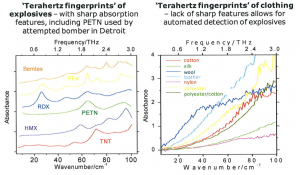By James Van Howe
 From TeraView press release Jan. 2010, THz Spectra of explosives (threats) and different clothing materials (non-threats).
From TeraView press release Jan. 2010, THz Spectra of explosives (threats) and different clothing materials (non-threats).
This post originally appeared on Jim’s Cleo Blog and is reproduced with permission from its author.
Today, the day before Thanksgiving, is one of the busiest holidays for air-travel in the U.S. The latest hubbub in U.S. airport security is the use of x-ray body scanners to detect for potential explosives or weapons carried by passengers. The scanners spray the traveler with soft x-rays and then detect the back-scattered radiation to produce an image of the passenger, minus his or her clothing. Many travelers have found this new level of security too invasive and have opted out for the traditional pat-down. Others have used their experience as the “butt” of jokes; Humorist Dave Barry recently described his ordeal of going through airport security of having both the scan and a pat-down due to a “blurry groin area” from the image. The threat of body-scanner boycotts from various websites and blogs prompted transportation security administration (TSA) chief John Pistole to plead to holiday-travelers to put security needs above personal modesty since the pat-down takes much longer and will lead to travel delays, inconvenience, and economic hardship for the travel industry.
The first thing that came to my mind in the flurry of stories I’ve been hearing regarding body-scanners and privacy issues was Terahertz (THz) radiation. What makes THz radiation useful for a body-scan is that it is readily transmitted through non-metallic and non-polar materials like clothing. However, there is more to THz imaging than just seeing through clothing which could make THz scanners both a more effective and less invasive tool than x-ray scanners.
Unlike x-rays, there are a number of explosive, chemical, and biological agents of interest for threat-detection that have characteristic THz spectra, including PETN which was found in the “underwear bomber’s” briefs after his foiled attempt to blow-up a plane near Detroit last Christmas. Rather than build up an image of the body and rely on the scanner operator to judge the potential threat from visual inspection, a THz scanner could look at the reflected spectra point-by-point to compile a molecular fingerprint by comparing to a database of absorbance spectra. Effectively, this technique is “THz spectroscopy through clothing”. You build up a chemical map across the body instead of a body image. TeraView of Cambridge announced work on such a scanner last January when the U.K. ran into similar passenger discontent over x-ray body-scans. Besides giving travelers back their modesty, this technique likely could give better threat detection as well as less false-positives since threats are identified chemically instead of visually.
To find the latest breakthroughs on THz scanners, be sure to attend sessions under CLEO: Science & Innovation: Terahertz Technologies and Applications, or CLEO: Applications & Technology: Government & National Science, Security & Standards Applications this May. Until then, have happy, safe, and hopefully noninvasive travels……for the full original post, click here.
Posted: 24 November 2010 by
James Van Howe
| with 0 comments